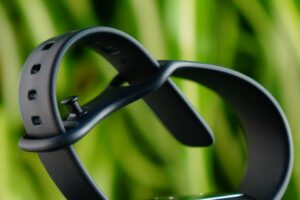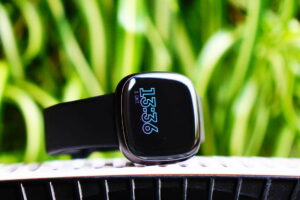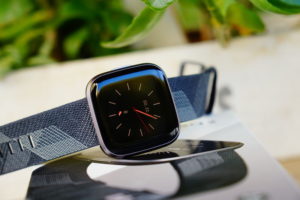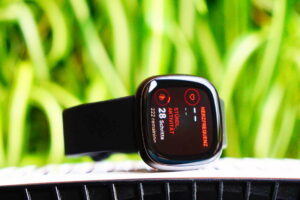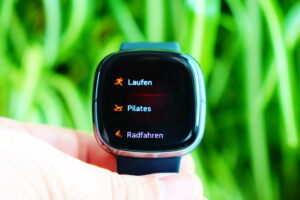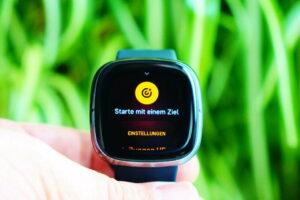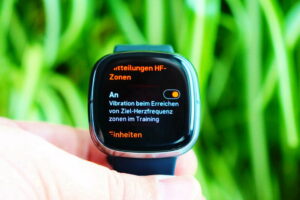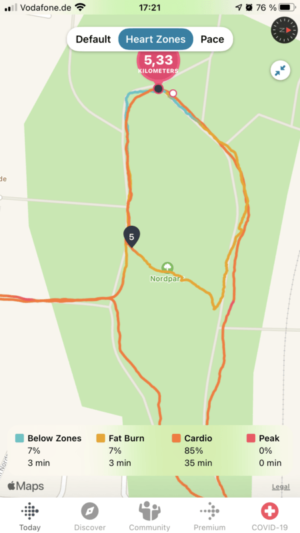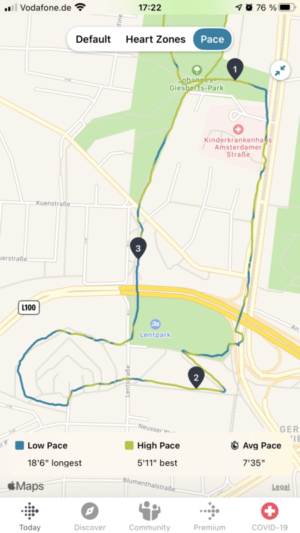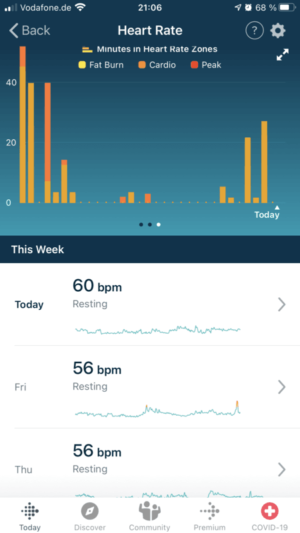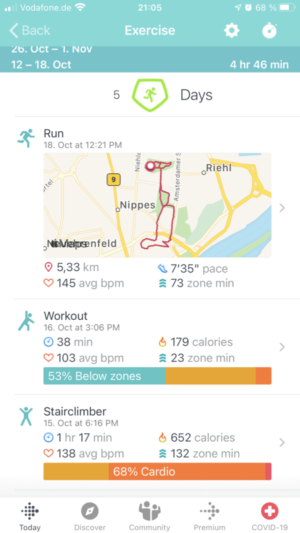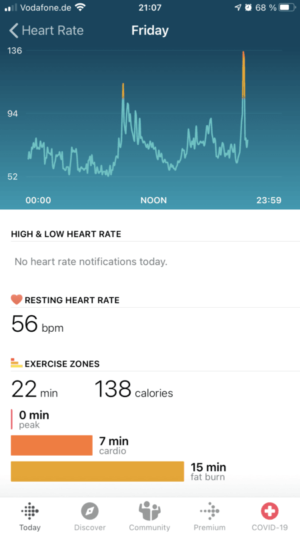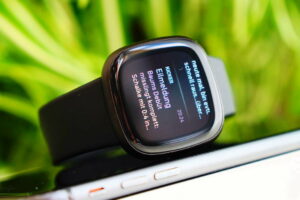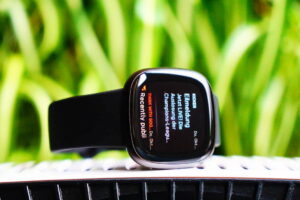The Fitbit Versa 3 fitness smartwatch has hardly changed in terms of appearance compared to its predecessor, however, several new features can still create interest in the newer model. Among them, an integrated GPS receiver enables precise workouts without a smartphone nearby.
For our review, we will go through some functions in quick succession. We also name strengths and some weaknesses that users should know before possibly making a purchase. Pricewise the manufacturer holds the line and calls again $229.95 (RRP). Let’s see for ourselves how the smartwatch performs

Bestsellers, deals, gift ideas*
Fitbit Versa 3: Highlights
Fitbit announces the following highlights for the Versa 3:
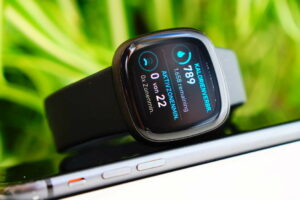
Special features
- Integrated GPS receiver
- New heart rate sensor
- Respiratory rate, heart rate variability (in conjunction with a Fitbit Premium account)
- New Health Metrics dashboard in conjunction with a Fitbit Premium account
- Larger AMOLED display with ambient light sensor and always-on option
- Google Assistant (up to now only Amazon Alexa was supported) with the latest update
- Make calls directly via the newly integrated microphone and loudspeaker in the smartwatch with the latest update
- Quick release mechanism for quick change of wristbands
Further
- 24×7 activity tracking (steps, calories, sleep tracker and more), Smart Wake-up
- SpO2 (measure/estimate oxygen saturation)
- Automatic recognition of certain activities (e.g. cycling)
- Integrated music streaming
- Waterproof to 50 meters
- Active Zone Minutes
- Fitbit Pay
 | Fitbit Versa 3 Price --- | |
Many features have also been added to older trackers of the manufacturer via update. However, these are only available in conjunction with a Fitbit Premium account ($9.99 per month or $79.99 per year). The Ionic, Versa 2 and Versa Lite will then have the functions SpO2, respiratory rate and heart rate variability available.
Fitbit Versa 3
In this Fitbit Versa 3 review, we will take a closer look at the fitness smartwatch. We have also reported on some other functions in our Versa 2 Review, for those interested in even more details. Overall, we liked the predecessor quite well. As a weakness, we criticized the lack of a GPS receiver due to its mid-range price. It can only do Connected GPS, which always involves carrying the smartphone alongside it.
Now the new model, like the equally new Sense (an ECG fitness smartwatch), has been upgraded with an integrated GPS receiver. This striking as well as further smaller upgrades fortunately did not lead to an increase of the RRP price of $229.95. However, from our point of view, the manufacturer now also supplies noteworthy, unexpected weaknesses that did not exist before. Some users can or have to get used to one of these, while workarounds are available for others. More on this in the following sections.
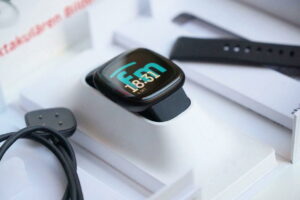
In the well-designed packaging, in addition to the high-quality finished smartwatch, there is also a USB charging cable and a longer replacement silicone strap for larger wrists. The new, proprietary change mechanism for the wristbands allows a very easy and quick exchange. When buying new wristbands, however, care must be taken to ensure that they conform to the new interface. Wristbands of the predecessor are unfortunately not compatible.
However, we have already come to the first point of criticism regarding the wristbands that come with the new interface. Specifically, we criticize the way the locking mechanism was implemented. Closing the wristband with one hand requires some practice. In addition, it can cause a somewhat annoying feeling on the underside of the wrist, because it is not always easy to get to the inner part of the wristband to pull it tighter. The following picture on the right side tries to clarify what we mean:
Versa 3: Handling that takes some getting used to
The aluminum housing and the very good AMOLED display with ambient light sensor of the Versa 3 from Fitbit are comparable to the previous model, which only has an AMOLED display. If both models are next to each other, they are hardly distinguishable from each other:
The initial setup via Bluetooth using the smartphone (in our case an iPhone 8 Plus) and an installed Fitbit app is quick and easy. In the course of setup, the WLAN interface can be connected to the home network, so that future synchronizations or software updates can be carried out more quickly.
By default, the display is switched off and can be activated, for example, by moving the arm. An always-on option can be found in the settings. This ensures that important data is always visible on the display, including time, date, battery life and some performance data during a workout. However, it does affect the battery life, as the smartwatch will only last for about 2 to 3 days instead of about 6 days.
It is controlled by swiping gestures on the display and a control button. The swiping gestures make everyday use much easier, but smaller jerking movements are always noticeable. In addition, some swiping gestures lead to unwanted actions. In particular, the notification display is rolled out all too often when the display is simply scrolled down. Here the tuning at the top of the screen seems to be in need of improvement.
At this point, we assume that there are software problems that can be fixed, which probably result from teething troubles with the new operating system Fitbit OS version 5. This was developed exclusively for both the Versa 3 and the Sense. According to the manufacturer, it should not be rolled out on older models.
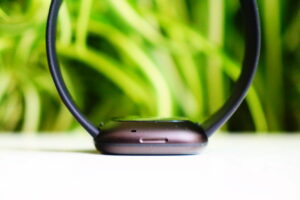
Somewhat more serious in our review is the criticism of the touch-sensitive control button on the left side of the case, which serves as a “back” and configurable shortcut button in menus. First of all, it is placed on the lower half of the case, which is a bit difficult to access and thus in some cases is difficult to grasp. Furthermore, it is recessed like on a Charge 4. Thirdly, it doesn’t always react as the user wants, so that controlling the smartwatch sometimes becomes a game of chance. Users can get used to it or lose the fun of the smartwatch. Everyone has to find that out for themselves. If you want to be on the safe side, take a look at the predecessor, which has a more tactile and easier to use button.
Versa 3 from Fitbit: versatile training possibilities
Fitbit offers on its fitness trackers good possibilities for general workouts and hobby sports, but if you want to develop your sport in a structured way, you should also take a look at alternatives from other manufacturers. For example, training plans for targeted competition preparation such as a half-marathon run, as well as the option of integrating a more reliable HR chest strap into the training during training, are offered by models from Garmin or Polar. Likewise, trackers from the manufacturer are still not able to transmit the recorded heart rate to other devices (HR-Broadcast). In times of compatible treadmills, rowing machines and the like this is a pity.
Some sports, such as running or cycling, are automatically detected by the smartwatch as soon as a time threshold (e.g. 12 minutes) is reached. For such detected activities, the GPS of the smartwatch is not turned on, but a suitable entry in the app is made automatically.
However, if users want to start GPS activities or configure the sports profile individually beforehand, the activity is selected and started manually. Other pre-installed activities include running, cycling, swimming, treadmill, weights, interval timers and general workouts. Because the housing is waterproof up to 5 ATM, it also survives being taken to the swimming pool. Below are sample images of the Sense’s adjustment options, which offer identical options at this point:
Furthermore, settings can be made for the GPS receiver (on/off) and display (activate always-on). In addition, further options such as Auto-Round, Auto-Pause, Reached destinations or alarms can be influenced:
The GPS receiver delivers overall useful results, but sometimes the route in the app is not displayed completely clean:

A run can also be displayed differently in the app. For example, more strenuous sections or speed differences can be better recognized:
By the way, a GPS activity can now also be exported as a TCX file, so that it can be imported and analyzed in other tools. After the activity the display shows a short summary. However, more detailed data and displays are available in the app and browser after synchronization, so that users can better understand the activity and its effects.
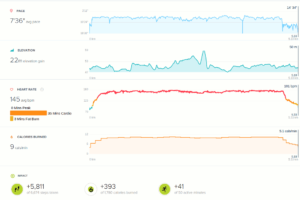
Everyday life
In everyday life, the Fitbit Versa 3, like all other models from the manufacturer, tracks various health metrics. These include, for example, steps, calories burned, sleep and heart rate, which is recorded around the clock. When counting steps, it can also be a bit more generous and prefer to add one or two steps. All in all, however, the step recordings provide a good guideline for everyday activities.
The sleep tracking of the smartwatch convinced us in the review. As a rule, sleep and wake-up times are recorded reliably and accurately. This results in a simple sleep index. With this number, sleep becomes more easily comparable. The number is made up of nightly measurements of heart rate, the time spent awake or restless and sleep phases. According to the manufacturer, the average value is between 72-83 points. The higher the value, the better and more restful the sleep was.
If users want to benefit from all the new health features, the new Health Metrics Dashboard can be upgraded with a paid Fitbit Premium account for $9.99 per month or $79.99 per year. Among other things, this will then unlock more in-depth details on some of the metrics. Among these, users can see analyses of respiratory rate, resting heart rate, SpO2 values and heart rate variability. We have summarized what HRV is and how it is used in modern wearables in our article HRV in sports smartwatches and wearables.
Smartphone notifications are reliably transmitted to the smartwatch display as long as the smartphone is nearby:
The streaming of music
The Versa 3 can stream music. However, only playlists of the music partners Deezer, Pandora and Spotify can be played. As a premium user of the Deezer music service, you can consider yourself lucky, because it is the only service that allows you to store offline music on your smartwatch.
Users of Spotify look like the predecessor in the tube. Because there is still only one Spotify app available on the smartwatch, which only allows some kind of control of the Spotify app on a smartphone. There is no offline synchronization of songs with the memory of the smartwatch. Consequently, the smartphone with Spotify open must always be nearby, for example to navigate between playlists or select the output destination for music playback. It is also worth mentioning that a Spotify Premium Account is required.

Furthermore, it should be mentioned that no own MP3 music files can be transferred to the smartwatch. This is only possible on the predecessor.
Fitbit Pay: Which banks are supported
The Versa 3 from Fitbit supports the Fitbit Pay payment service. For this purpose, the manufacturer has installed an NFC chip in the device, which enables contactless payment with the smartwatch. A complete list of supported banks is available here.
Versa 3: What about the speaker?
The Versa 3 also has an integrated speaker as another key differentiator from its predecessor. There is a lot of confusion about how to interact with it. As of today the speaker is activated only with the latest update 5.1.
The update allows the smartwatch to be used together with the microphone as a hands-free device. After this activation, answers from the voice assistants from Amazon and Google are also heard over the loudspeaker. The smartphone must always be nearby so that the interaction with the assistants works and the voice data can be processed, so at the moment it is still the same as on the predecessor: Answers from Alexa (Google Assistant) can only be seen as text on the display.
Versa 3, Versa 2 or Sense?
The Versa 3 offers a few new features, but its predecessors have caught up considerably. However, unfortunately only in conjunction with a paid Fitbit Premium account. All of the manufacturer’s trackers reliably track daily activities and offer great opportunities for sports activities. In the new model, the only important distinguishing feature is the GPS receiver and the built-in speaker. At the moment, we rather recommend the use of the cheaper predecessor model if no GPS receiver is needed or Connected GPS is sufficient and the new functions are not so important to the user. We feel that the weaknesses in the operation of the new model are currently too important. However, the manufacturer was able to make improvements via software update.
The alternative Sense has practically the same weaknesses in operation, but can score points at the expense of the wallet with striking exclusive functions that are not available from the competition. The most important one is the mobile, CE-certified 1-channel ECG function, which generates an ECG within 30 seconds. When exported as a PDF file, it can be quickly and easily sent to a specialist for further analysis, who can examine it for signs of atrial fibrillation.
In addition, the Sense can also detect an unusually high or low heart rate and inform the user. Furthermore, it has a skin temperature sensor which, compared to the Versa 3, can provide statistics about the temperature on the skin surface every minute. It is also equipped with a sensor for electrodermal activity (EDA) to support stress management. So the Sense provides a much more comprehensive view of health, but users only see a lot of data, which is little correlated by the app. In our view, the average user will have practically no use for this data as long as Fitbit does not offer a little more support even without Fitbit Premium.
Versa 3: Prices, sales start, model variants
The Versa 3 is now available in different colors for $229.95 (RRP), although the price in stores has already dropped a little. Here for example the smartwatch can be bought:
 | Fitbit Versa 3* --- | |
Fitbit Versa 3 Review: Conclusion
In the Fitbit Versa 3 review the fitness smartwatch could not always convince us. Although it offers a few improvements, it also brings too many compromises and new weaknesses. One of these is the fiddly buckle of the wristband. Also worth mentioning is the new proprietary interface of the Quick Release mechanism, which only allows corresponding wristbands. Furthermore, the slightly hidden button takes some getting used to and the new operating system seems to need some fine tuning.
On the other hand, it looks great on the wrist, offers a very good display and the case is undoubtedly well made. From a sporting point of view, the GPS receiver is a real upgrade to its predecessor and represents added value. Together with the new Fitbit OS operating system and the announced features, the smartwatch should become even more interesting as soon as they are added.
As alternatives we suggest the Versa 2, which after all is capable of Connected GPS. Or in the competition the Venu Sq, which is in a similar price segment and even looks similar.
Versa 2
 | Versa 2 Price $194.99 | |
Venu Sq
 | Garmin Venu Sq Price $159.99 | |

